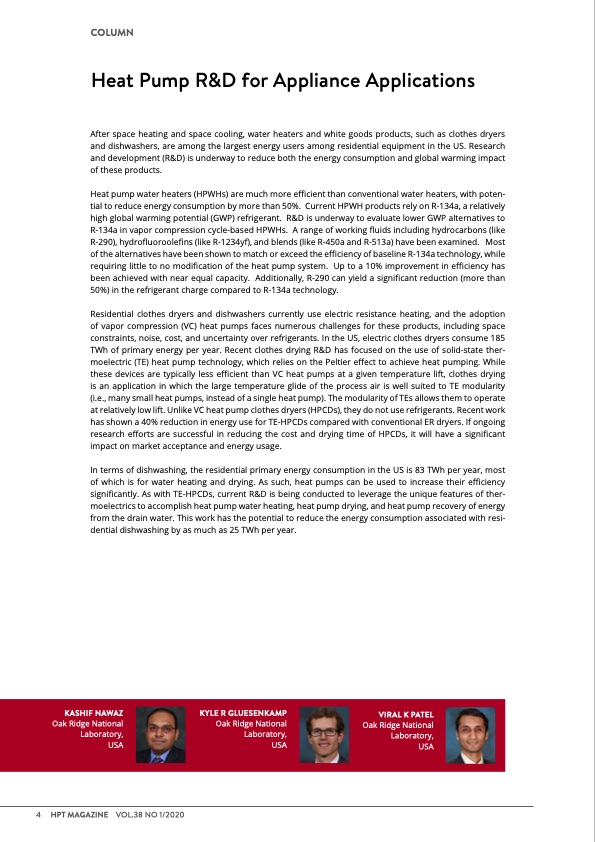
PDF Publication Title:
Text from PDF Page: 004
KASHIF NAWAZ Oak Ridge National Laboratory, USA KYLE R GLUESENKAMP Oak Ridge National Laboratory, USA VIRAL K PATEL Oak Ridge National Laboratory, USA COLUMN Heat Pump R&D for Appliance Applications After space heating and space cooling, water heaters and white goods products, such as clothes dryers and dishwashers, are among the largest energy users among residential equipment in the US. Research and development (R&D) is underway to reduce both the energy consumption and global warming impact of these products. Heat pump water heaters (HPWHs) are much more efficient than conventional water heaters, with poten- tial to reduce energy consumption by more than 50%. Current HPWH products rely on R-134a, a relatively high global warming potential (GWP) refrigerant. R&D is underway to evaluate lower GWP alternatives to R-134a in vapor compression cycle-based HPWHs. A range of working fluids including hydrocarbons (like R-290),hydrofluoroolefins(likeR-1234yf),andblends(likeR-450aandR-513a)havebeenexamined. Most of the alternatives have been shown to match or exceed the efficiency of baseline R-134a technology, while requiring little to no modification of the heat pump system. Up to a 10% improvement in efficiency has been achieved with near equal capacity. Additionally, R-290 can yield a significant reduction (more than 50%) in the refrigerant charge compared to R-134a technology. Residential clothes dryers and dishwashers currently use electric resistance heating, and the adoption of vapor compression (VC) heat pumps faces numerous challenges for these products, including space constraints, noise, cost, and uncertainty over refrigerants. In the US, electric clothes dryers consume 185 TWh of primary energy per year. Recent clothes drying R&D has focused on the use of solid-state ther- moelectric (TE) heat pump technology, which relies on the Peltier effect to achieve heat pumping. While these devices are typically less efficient than VC heat pumps at a given temperature lift, clothes drying is an application in which the large temperature glide of the process air is well suited to TE modularity (i.e., many small heat pumps, instead of a single heat pump). The modularity of TEs allows them to operate at relatively low lift. Unlike VC heat pump clothes dryers (HPCDs), they do not use refrigerants. Recent work has shown a 40% reduction in energy use for TE-HPCDs compared with conventional ER dryers. If ongoing research efforts are successful in reducing the cost and drying time of HPCDs, it will have a significant impact on market acceptance and energy usage. In terms of dishwashing, the residential primary energy consumption in the US is 83 TWh per year, most of which is for water heating and drying. As such, heat pumps can be used to increase their efficiency significantly. As with TE-HPCDs, current R&D is being conducted to leverage the unique features of ther- moelectrics to accomplish heat pump water heating, heat pump drying, and heat pump recovery of energy from the drain water. This work has the potential to reduce the energy consumption associated with resi- dential dishwashing by as much as 25 TWh per year. 4 HPT MAGAZINE VOL.38 NO 1/2020PDF Image | Integration of Heat Pumps into the Future Energy

PDF Search Title:
Integration of Heat Pumps into the Future EnergyOriginal File Name Searched:
HPT-Magazine_no1_2020.pdfDIY PDF Search: Google It | Yahoo | Bing
CO2 Organic Rankine Cycle Experimenter Platform The supercritical CO2 phase change system is both a heat pump and organic rankine cycle which can be used for those purposes and as a supercritical extractor for advanced subcritical and supercritical extraction technology. Uses include producing nanoparticles, precious metal CO2 extraction, lithium battery recycling, and other applications... More Info
Heat Pumps CO2 ORC Heat Pump System Platform More Info
| CONTACT TEL: 608-238-6001 Email: greg@infinityturbine.com | RSS | AMP |